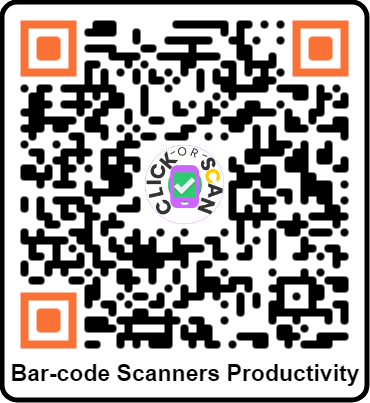Bar-code Scanners Improve Productivity
In today’s fast-paced business environment, the quest for efficiency and accuracy is paramount.
Bar-code Scanners Improve Productivity and have emerged as vital tools in this pursuit, revolutionizing how companies manage inventory, streamline operations, and enhance overall productivity.
By automating the data collection process, these devices minimize human error and expedite transactions, allowing businesses to focus on their core competencies.
The integration of bar-code scanning technology not only facilitates quicker checkouts and improved stock management but also provides real-time insights into inventory levels and sales trends.
As companies seek to optimize their workflows and reduce operational costs, the adoption of bar-code scanners has become increasingly prevalent across various industries, from retail and logistics to manufacturing and healthcare.
This article delves into the myriad ways bar-code scanning systems are transforming workplace efficiency, exploring their impact on workforce productivity, accuracy in inventory control, and the overall customer experience.
By examining case studies and industry trends, we will highlight how businesses can harness the power of bar-code scanners to achieve significant gains in efficiency and competitive advantage.
Table of Contents Bar-code Scanners Improve Productivity
Bar-code scanners streamline inventory management processes effectively
The integration of bar-code scanners into inventory management systems significantly enhances operational efficiency by automating data entry and tracking.
With the ability to quickly capture and process product information, these devices minimize human error and reduce the time spent on manual counting and recording.
As a result, businesses can maintain accurate stock levels and improve order fulfillment, ultimately leading to a more responsive supply chain.
Moreover, the real-time data provided by bar-code scanners allows for better decision-making and resource allocation.
Inventory discrepancies can be identified and addressed promptly, preventing stockouts or overstock situations.
This level of visibility and control not only optimizes inventory turnover but also contributes to a more organized storage environment, enhancing overall productivity across various departments within the organization.
Improved accuracy reduces human error significantly
The deployment of bar-code scanning technology fundamentally transforms the accuracy of data capture in inventory management.
By automating the recording process, these systems eliminate the inconsistencies often associated with manual entry, such as misreads or transpositions.
This heightened accuracy not only ensures that inventory records are reliable but also fosters a culture of accountability, as employees can trust the data they are working with.
With fewer errors to correct, staff can devote more time to strategic tasks rather than being bogged down by discrepancies.
In addition to enhancing reliability, the adoption of bar-code scanners streamlines workflow processes, as the time spent on checks and corrections is significantly reduced.
Employees can swiftly verify stock levels, process orders, and manage shipments with confidence, knowing that the information they are acting upon is precise.
Ultimately, this leads to improved customer satisfaction, as accurate inventory levels translate to timely and accurate deliveries, reinforcing a company’s reputation for dependability in a competitive marketplace.
Faster data entry enhances overall efficiency
By significantly reducing the time required for data entry, the integration of bar-code scanning technology allows businesses to allocate resources more effectively.
Employees can complete tasks more quickly, leading to shorter lead times in inventory management and order fulfillment.
This increase in speed not only boosts individual productivity but also contributes to a more agile operation that can respond rapidly to market demands.
Moreover, the streamlined processes facilitated by bar-code scanners promote a more organized workplace, where employees can focus on high-value activities instead of spending time on repetitive data entry tasks.
The resultant efficiency enhances overall operational performance, enabling businesses to achieve their objectives more effectively.
In a competitive landscape, leveraging such technology not only enhances the day-to-day functions of staff but also elevates the organization’s ability to innovate and grow.
Real-time tracking optimizes supply chain operations
Integrating real-time tracking within supply chain operations enables organizations to gain unprecedented visibility into their inventory and logistics processes.
By utilizing advanced tracking technologies, companies can monitor the movement of goods at every stage, from manufacturing to delivery.
This immediacy of information allows for timely decision-making, reducing the risk of stockouts or overstock situations, which are detrimental to operational efficiency and profitability.
With real-time insights, businesses can predict potential disruptions and adjust their strategies proactively, enhancing their overall responsiveness to market fluctuations.
Furthermore, the ability to track assets in real-time fosters greater collaboration among supply chain partners.
Improved communication channels, driven by accurate data sharing, help to align supply and demand more effectively.
This interconnectedness not only supports better inventory management but also strengthens relationships with suppliers and customers, creating a more resilient supply chain.
As a result, organizations can optimize their resource allocation and enhance customer satisfaction through timely deliveries and improved service levels.
Inventory counts become quicker and easier
The implementation of bar-code scanning technology significantly streamlines the inventory counting process.
By digitizing and automating data entry, organizations can eliminate the tedious manual counting that often leads to human error.
Scanners quickly read bar codes, capturing critical information instantly, which allows for more accurate and efficient inventory verification.
As a result, businesses can complete stock counts in a fraction of the time previously required, freeing up resources to focus on other essential areas.
Moreover, the integration of scanning devices with inventory management systems enhances data accuracy and availability.
This synergy allows for real-time updates, ensuring that inventory records reflect the current stock levels without delay.
With faster, more precise inventory counts, companies can respond promptly to fluctuations in demand and improve overall operational efficiency.
This not only reduces the time spent on audits and reconciliations but also contributes to better planning and forecasting, driving profitability and customer satisfaction.
Reduced training time for employees necessary
Efficient training programs are crucial in maximizing the benefits derived from advanced technologies like bar-code scanning.
By utilizing user-friendly scanning devices, organizations can significantly minimize the time required for employee training.
The intuitive nature of these tools enables new hires to quickly grasp their functionality, allowing them to become productive contributors much sooner.
This reduction in training time not only enhances workforce efficiency but also leads to a more agile organization that can adapt to changes in operational needs swiftly.
Additionally, streamlined training processes facilitate quicker onboarding, which is particularly advantageous in fast-paced business environments.
Employees can achieve competency in essential tasks without extensive training periods, leading to reduced labor costs and improved employee morale.
Ultimately, this approach fosters a culture of continuous improvement where staff can invest their efforts in enhancing skills and productivity rather than spending excessive time on training, thereby driving overall organizational success.
Integration with software increases operational productivity
Leveraging technology through integration with existing software systems enhances overall operational efficiency across various business functions.
By allowing bar-code scanners to communicate seamlessly with inventory management, sales, and logistics platforms, organizations can ensure accurate real-time data transfer, reducing the risk of human error associated with manual entries.
This connectivity not only streamlines workflows but also enables teams to make informed decisions quickly based on up-to-date information.
Moreover, the integration facilitates comprehensive reporting and analytics, empowering businesses to identify trends, optimize inventory levels, and enhance customer service.
By automating routine tasks and providing insights into operational metrics, employees are freed from time-consuming manual processes, allowing them to focus on higher-value activities.
As a result, organizations can achieve significant gains in productivity, ultimately leading to improved service delivery and competitive advantage in their respective markets.
Enhanced customer service through faster checkout
The implementation of efficient scanning technologies significantly reduces the time customers spend at checkout, transforming their overall shopping experience.
With quick and accurate item recognition, transactions can be completed in a fraction of the time it would take with traditional checkout methods.
This not only minimizes wait times but also enhances customer satisfaction, as shoppers can swiftly move through the purchasing process without unnecessary delays or frustrations.
Moreover, faster checkouts contribute to higher transaction volumes during peak hours, enabling retailers to serve more customers effectively.
This increased efficiency not only boosts sales but also cultivates customer loyalty, as individuals are more likely to return to an establishment that prioritizes their time and convenience.
In essence, optimizing the checkout process through advanced scanning technologies plays a crucial role in reinforcing a business’s commitment to exceptional customer service.
Cost savings from reduced labor hours
Utilizing advanced scanning technologies can lead to significant cost savings by minimizing the labor hours required for checkout operations.
With automated systems that streamline item scanning and transaction processing, fewer staff members are needed at registers, allowing businesses to allocate their workforce more efficiently.
This reduction in hours can translate directly into lower payroll expenses, providing retailers with increased flexibility to redirect those savings toward other critical areas, such as inventory management or marketing initiatives.
Additionally, as tasks become more efficient, employees can be retrained to focus on higher-value activities, such as customer engagement and enhancing the shopping experience.
This shift not only maintains staff productivity but also contributes to a more knowledgeable and service-oriented workforce.
Overall, the impact of reducing labor hours through improved scanning processes demonstrates a clear advantage for businesses aiming to enhance their operational efficiencies while managing costs effectively.
Overall business performance improves with automation
Enhanced efficiency through automation not only streamlines operations but also elevates overall business performance.
By integrating automated scanning systems, businesses can achieve higher accuracy in inventory management, leading to reduced stock discrepancies and improved fulfillment rates.
This optimization ensures that products are readily available for customers, which can significantly boost sales and enhance customer satisfaction.
Consequently, the combination of accuracy and speed in processing transactions creates a more responsive supply chain, positioning businesses favorably in competitive markets.
Furthermore, the data collected through automated systems provides valuable insights that can inform strategic decision-making.
With real-time analytics on sales patterns, inventory turnover, and customer preferences, organizations can make informed adjustments to their operations.
This intelligence allows businesses to respond proactively to market demands and trends, ultimately driving growth and profitability.
As automation continues to transform traditional workflows, companies that embrace these technologies are better equipped to adapt and thrive in an ever-evolving business landscape.
In conclusion, the implementation of bar-code scanners has proven to be a transformative force in enhancing productivity across various industries.
By streamlining inventory management, reducing human error, and accelerating the checkout process, these devices not only optimize operational efficiency but also improve overall customer satisfaction.
As businesses continue to adopt advanced technologies, the role of bar-code scanners will remain integral in driving productivity and ensuring competitive advantage in an increasingly fast-paced market.
Embracing these tools is not just a matter of keeping pace; it is a strategic move towards achieving sustained growth and operational excellence.








